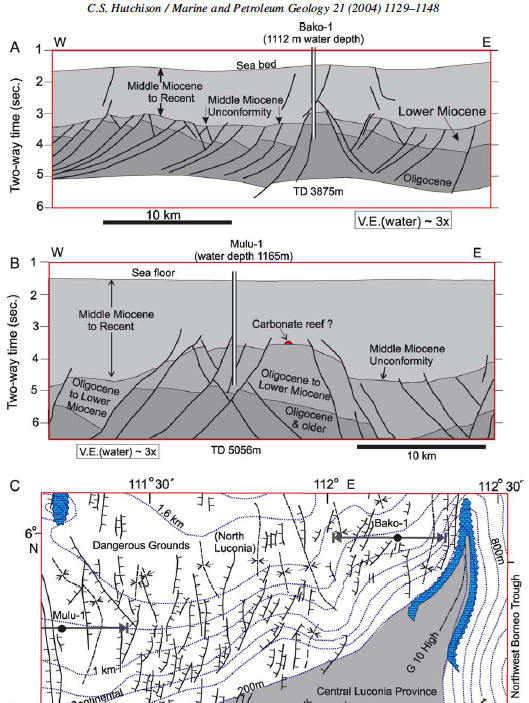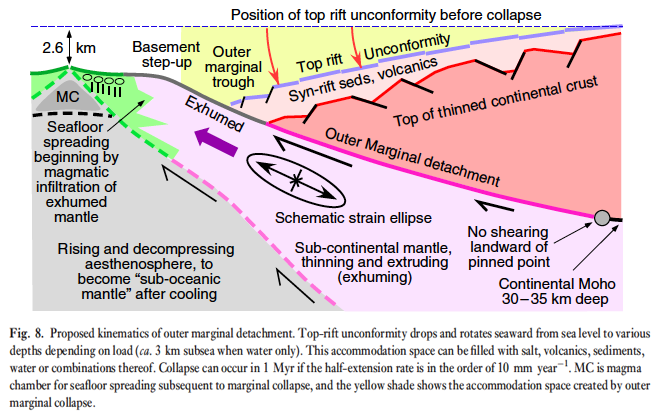This term is commonly used describing big-picture geology, for example Hutchison (2004) describing the South China Sea: ”… the break-up unconformity marking the transition from active rifting of the Sundaland margin to sea-floor spreading.” It is usually defined on morphology and is an irregular buried topography seismic surface, usually covered by a drape of condensed sediment. Hutchison described break-up type unconformities in western areas of the South China Sea, even though there is no evidence that rift reached true break-up and drift in that area (Mulu and Bako wells in North Luconia). As Hall and Breitfeld (2017) – and Hutchison himself had noted – the Oligocene through Miocene rifting and drifting in the South China Sea was restricted to the area NE of the West Baram Line (see the post on the difference between the Sarawak and Sabah orogenies).

Not only are ages of the events poorly documented in most old papers but the vertical facies contrast over the unconformity is very vaguely described. Hutchison 2004 again: “Isostatic equilibrium requires a progressive increase in depth of water with attenuation after the break-up unconformity” … “The strata are bathyal because the Dangerous Grounds Province subsided resulting from isostatic adjustment following crustal attenuation and the break-up MMU.”
This is not what the well data sees, with classic non-Waltherian contacts; thick delta-plain deposits laid down near sea-level suddenly overlain by thick bathyal clays with no discernible transitional facies. That is “the bottom dropped out of the area” at a very high rate, and rapidly resulted in many hundred of metres of vertical displacement. This type of rapid movement is not really explicable by thermally driven isostatic adjustment. The crust had thinned through shearing and presumably stayed in isostatic equilibrium, yet the final crustal failure is not proposed to have been accompanied by any sudden widespread thinning that would then sink due to the reduced isostatic load. Thermal contraction and sinking is the only candidate left, but this is a slower process. For a long time this discrepancy was overlooked.
In 2014 a paper by Pindell et al. began to look at this problem. The noted the collapse of continental margins: “… post-dates rifting and stretching of the crust, but occurs roughly ten times faster than thermal subsidence of young oceanic crust, and thus is tectonic and pre-dates the ‘drift stage’. We term this middle stage of margin development ‘outer margin collapse.” … “We use the term ‘collapse’ because of the apparent rapidity of deepening (<3 Myr).” This was based on Mesozoic examples and within one biozone was cited as approximating < 3 Myr. In the Cenozoic of SE Asia we would agree with this “within one bizone” but here the combined foraminiferal, nannofossil and strontium dated zones have almost a resolution of 1 Myr and the break up happens within a single such zone. Within the text of their paper and stressed in a 2014 AAPG Search and Discovery summary (from the September AAPG conference) Pindell et al. revised their estimate to “ the rapidity of the deepening, which seems to be <3 Ma, and possibly <1 Ma”

The tectonic mechanism proposed by Pindell at al. was a rapid transition at the end of rift and before drift sedimentation, whereby the upper lithosphere (crust) detached along an outer marginal detachment, rotated and retreated. This forced rapid isostatic adjustment and: “At magma-poor margins, outer continental margins collapse and tilt basinward to depths of about 3 km subsea at the continent–ocean transition, often deeper than the adjacent oceanic crust (accreted later between 2 and 3 km).” Pindell et al. also noted “We suggest that backstripping estimates of lithospheric thinning (beta factor) at outer continental margins may be excessive because they probably attribute marginal collapse to thermal subsidence.” This would tally with the observations of Clift et al. (2002) and others who could not reconcile high observed subsidence with low modelled subsidence, and had to increase beta-factors, usually in the lower lithosphere, to explain the high thermal subsidence.
Of course in South East Asia with high sedimentation rates new siliciclastics in the suddenly created new accommodation space would begin loading and the basin would sag over a gradually increasing area, compounded by the thermal subsidence. However the sudden outer marginal collapse explains the abrupt non-Waltherian contacts that correlate over wide areas of the South China Sea; strong near the rift axes, and fading in a predictable way with distance from these focal areas.
The only problem is there are just two known periods of rift to drift, at c 34 Ma in the NE South China Sea and c. 24 Ma after ridge jump into the central South China Sea. In contrast there are 4 different candidate break-up style events; at 34 Ma (Blue* of Hinz & Schluter 1985, or T8 of Xia and Zhou 1993), at 28 Ma (T7), 24 Ma (Blue or T6), and the 16 Ma event (in west Luconia); possibly Red or T4 in the eastern SCS schemes). Each of these events is accompanied by:
- Very rapid subsidence of many hundreds of metres, perhaps over a km, in the axis
- The subsidence is immediately followed by new carbonates appearing on the flanks in a location more proximal to the continent, or on horsts, where subsidence was less extreme
- The rapid migration and retreat of siliciclastic systems which resulted in condensed sedimentation over the buried topography around the axis of extension.
In the Makassar Straits people have not often used the term break-up unconformity as there is no known break-up, and therefore it seems inappropriate, but buried topography surfaces are seen on seismic, and geohistory analysis shows that there are five major unconformities. These unconformities all have the three key properties listed above; at about 39-38 Ma, 36 Ma, 34 Ma, weakly at 28 Ma, and at 24 Ma.
A new model is required
Not only is there correlation in timing of three break-up events between the Makassar Straits and the South China Sea, but all the Makassar Straits events correlate with movement in the transform wrench zone under the island of Java. Clearly the mechanism of Pindell et al. is only a partial model for the extension and subsidence under Sundaland. Geohistory analysis, using evidence-based stratigraphic input, will be an important part of any new tectono-stratigraphic research. The clues to a new model may come from anomalies such as the c. 28 Ma event which, while focused in the northeastern South China Sea, where there was true break-up (at c 34 and 24 Ma), lacked any new drift at c 28 Ma. There is clearly accelerated subsidence over a wide area (probably including the termination of the Nummulitic reef at IODP site U1504, correlating to the major unconformity in site 1148 just above the extinction datum of Chiloguembelina cubenis at 28.4 Ma), but the only other tectonic feature appears to have been the end of asymmetrical spreading in the NE SCS (Nirrengarten et al., 2019), followed by symmetrical rates of drift. In the western South China Sea the rifting of the Bunguran Trough has no evidence for drift, yet it has all the characteristics of a break-up unconformity. As a result in north Luconia, where the deep section has been drilled, there are two break-up unconformities at 24 and 16 Ma, which is a further anomaly as the rift to drift transition should be a unique event (although, as Pindell et al noted, the effects could move “diachronously” along strike).
As the wrench zone under Java shows the same timing of movement as the extensional phases in the Makassar Straits (Luan and Lunt 2021a,b), it is a valid question to ask if the suspected wrench movement in North Sumatra is also linked, with candidate tectono-stratigraphic unconformities at 34, 28, 24 and 16 Ma. (Four out of four big events. This is not cherry-picking out of a bigger list of candidates. It is a statistically significant correlation). In the mid-Oligocene (28 Ma) an area of about fifty to a hundred thousand square kilometres, that had previously been extending and filling with fluvio-deltaic beds, was subjected to a rapid acceleration in subsidence. This was revealed first by basic stratigraphy and geohistory analysis (Lunt 2019), but this description lacked a unifying crustal mechanism. It is thought to be an opening due to wrenching, but why was such a wide area subject to both initial extension and then accelerated crustal thinning rather than a single, narrow, deep rift. Considering the correlation in time to mid-Oligocene events in eastern Sundaland it may be possible to find a single lithospheric mechanism that explains all these coeval extensional events
References
Clift, P., J. Lin, and U. Barckhausen., 2002, Evidence of low flexural rigidity and low viscosity lower continental crust during continental break-up in the South China Sea. Marine and Petroleum Geology 19, no. 8: 951-970.
Hall, R., and T. H. Breitfeld., 2017, Nature and demise of the Proto-South China Sea. Geological Society Malaysia Bulletin 63, 61-76.
Hinz, K., and H. U. Schlüter., 1985, Geology of the Dangerous Grounds, South China Sea and the continental margin off southwest Palawan: results of Sonne Cruises SO-23 and SO-27. Energy 10, no. 3/4: 297-315.
Hutchison, C. S., 2004, Marginal basin evolution: the southern South China Sea. Marine and Petroleum Geology 21, 1129-1148.
Jian, Z., Larsen, H.C., Alvarez Zarikian, C.A., and the Expedition 368 Scientists, 2018. Expedition 368 Preliminary Report: South China Sea Rifted Margin. International Ocean Discovery Program. https://doi.org/10.14379/iodp.pr.368.2018
Lunt, P., 2019, Partitioned transtensional Cenozoic stratigraphic development of North Sumatra. Marine and Petroleum Geology 106, 1-16
rten, M., Mohn, G., Kusznir, N.J., Sapin, F., Despinois, F., Pubellier, M., Chang, S.P., Larsen, H.C., Ringenbach, J.C., 2020. Extension modes and breakup processes of the southeast China-Northwest Palawan conjugate rifted margins. Marine and Petroleum Geology 113, 104123
Pindell, J., R. Graham, and B. Horn., 2014, Rapid outer marginal collapse at the rift to drift transition of passive margin evolution, with a Gulf of Mexico case study. Basin Research 26, no. 6: 701-725
Pindell, J., R. Graham, P. Bellingham, and B. Horn., 2014, Outer Marginal Collapse Separates the Rift and Drift Stages of Continental Margin Formation. AAPG International Conference & Exhibition, Istanbul, Turkey
Be First to Comment